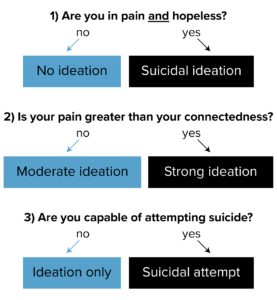Reducing access to firearms for suicide prevention
Temporarily reducing access to lethal means — putting time and space between someone who may attempt suicide and lethal means, specifically firearms — makes it more likely they will survive a suicide attempt. Though a person may consider suicide for a long time (providing opportunities for intervention and risk reduction), suicidal crises peak relatively quickly for many people. Access to firearms during that high-risk time period is a key factor in whether or not a person will survive.
According to the model created by researchers from Harvard University, limiting access to lethal means may lead to (1) substituting means (which is less common) or (2) temporarily or permanently delaying suicide attempts. If attempts are made with substituted means, they are generally less fatal, allowing time for suicidal crises to pass and leading to fewer suicides. Alternatively, if suicide attempts are delayed altogether without means substitution, the suicidal crises again may pass and result in fewer suicides. Through either path, temporarily reducing access to firearms for individuals who are at an elevated risk of suicide is likely to reduce suicide rates at the population level.

Model source: Barber CW & Miller MJ. (2014). Reducing a suicidal person’s access to lethal means of suicide: A research agenda. American Journal of Preventive Medicine.
The Three-Step Theory of Suicide outlines how suicidal thoughts progress into suicide attempts and highlights how, in the third step, limiting access to lethal means is critical for suicide prevention:
- The first step is suicidal ideation, which is due to a combination of pain (often psychological) and hopelessness.
- Second, a lack of connectedness escalates suicidal ideation.
- Third, there must be capability to attempt suicide, which is made up of dispositional (genetic), acquired (experience), and practical factors (concrete elements that make a suicide attempt easier).
When given pain, hopelessness, and a lack (or perceived lack) of connectedness, access to a firearm is considered a practical contributor to the capacity to attempt suicide. Reducing access to firearms is an important intervention point in the third step of the theory, focusing on the how, rather than the why, of suicide.

Model source: Klonsky ED & May AM. (2015). The three-step theory (3ST): A new theory of suicide rooted in the “ideation-to-action” framework. International Journal of Cognitive Therapy.